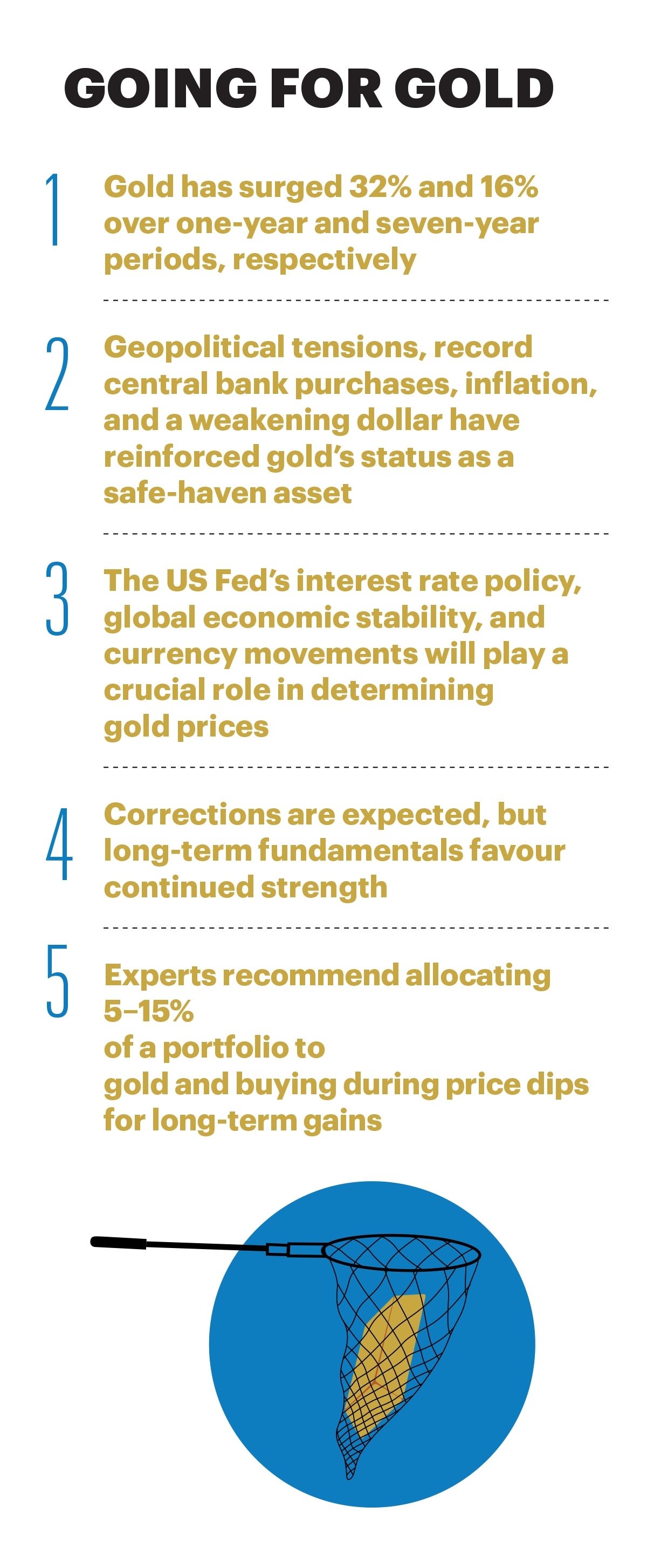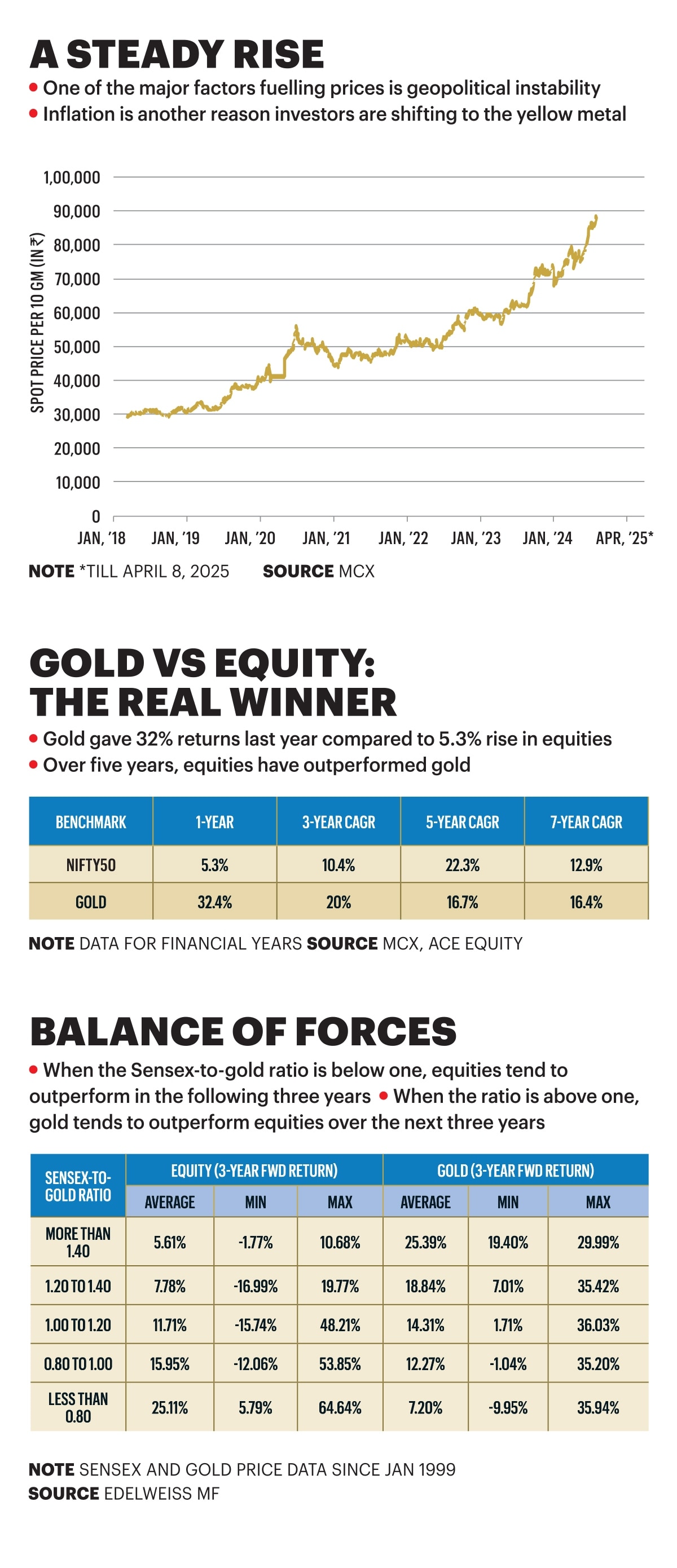

Gold has once again become an alluring prospect across the world—this time because of US President Donald Trump’s unilateral imposition of “reciprocal” tariffs on 60 countries. His announcement has sent ripples through global markets, unsettling investors and triggered an escalating trade war.
As always in times of turmoil, all eyes turn to gold—the timeless safe-haven asset.
“The imposition of US tariffs is likely to fuel inflationary pressures, with projections suggesting US inflation could rise above 5%, while GDP growth risks turning negative,” says Vandana Bharti, Head of Commodity Research at SMC Global Securities. In this tumultuous period—where corrections are being seen across asset classes including bonds, the dollar, equities, and commodities—gold is emerging as a key hedge.
As of now, gold has outperformed major asset classes, with prices rising over 15% year-to-date. “Central bank purchases, which reached a record high of over 1,100 tonnes in 2023 according to the World Gold Council, along with steady inflows into gold ETFs, are expected to continue supporting the rally,” adds Bharti.
This resurgence in gold demand has come after a phase where equities and risk assets dominated investor attention, leaving gold somewhat on the sidelines. Gold delivered returns of 12% and 16%, respectively, in FY24 and FY23, per MCX. But the returns have become phenomenal now. In the last financial year, gold delivered 32%, compared to 5.3% by the benchmark Nifty50 index. In a remarkable turnaround, since the beginning of this calendar year, gold has yielded 17% returns till April 8, with international prices soaring past $3,100 per ounce and domestic prices in India crossing Rs 90,000 per 10 grams.

Kishore Narne, Director and Head of Commodities of trading platform Motilal Oswal Financial Services says, “Gold prices have found strong support this year, driven by heightened geopolitical tensions and tariffs, which significantly boosted the metal’s appeal.”
Additionally, central banks are hoarding gold at record levels. Over 1,000 tonnes of gold were added to global reserves in 2024 alone, with countries like China, Russia, and India aggressively increasing their holdings to reduce dependence on the US dollar.
“Given the global uncertainty and heightened volatility in the dollar, most central banks want to diversify and reduce their dependency on dollar-linked issuances,” says Vishal Bajaj, Director—Wealth at wealth advisory firm Client Associates.
Inflation is another catalyst. Historically, gold has served as a hedge against inflation, and with US inflation rates seen spiking to 3%, much above the US Federal Reserve’s 2% target, investors are increasingly turning to the metal as a store of value. Additionally, physical demand in India and China—the world’s largest gold consumers—has remained strong.
SGBs: a growing liability?
Sovereign Gold Bonds (SGBs), government securities issued by the Reserve Bank of India (RBI), had gained immense popularity, allowing investors to gain exposure to gold without the hassle of physical storage. Since these bonds are government-backed and offer a 2.5% annual interest rate, they became a preferred choice for many.
Consider this: The RBI has raised funds equivalent to 147 tonnes of gold through SGBs. This is substantial compared to the 876 tonnes of gold reserves held by the RBI in 2024.

A closer look at the initial tranche of SGBs highlights the growing financial burden. The government initially raised Rs 245 crore, with investors purchasing gold at Rs 2,684 per gram in November 2015. At the time of redemption on November 20, 2023, the gold price had surged to Rs 6,132 per gram, marking a 120% increase. When factoring in the fixed annual interest, the total payout to investors rose to Rs 610 crore, reflecting a 148% increase in cost to the government—an annual rate of 12%.
The RBI has issued 67 tranches and only three series (seven tranches) have been redeemed so far. Hence, the sharp rise in gold prices has further intensified the fiscal strain. The total cost would have been far lower if the government had raised the same funds through traditional bonds at a 7% interest rate.
This financial pressure is one of the key reasons for the discontinuation of SGBs. But the bigger question remains: Does gold’s rally still have room to run, or is a correction on the horizon?
SUSTAINABLE RALLY?
While gold’s rally has been impressive, its sustainability is debatable. But Narne remains optimistic: “Given the current global environment, we believe the overall trajectory for gold could remain upward.”
Multinational investment bank and financial services company Goldman Sachs has revised its 2025 price forecast to $3,300 per ounce, up from its previous $3,100 estimate, with an expected range of $3,250-3,520 per ounce.
Shanmuganathan Nagasundaram, an economist based in India, has drawn parallels between the 1970s and today. In the ’70s, gold prices rose nearly 25 times to top at $850 per ounce by 1980. That is a 25-fold return in 10 years; a similar performance would mean $75,000 per oz by 2035. He says the next few years will determine if gold goes to that level, and at this point, it does looks like a reasonable proposition. What is almost certain is the target of $24,000 per oz, as explained in his book, RIP USD: 1971-202X …and the Way Forward, and that would still be a spectacular bull market.

However, several factors, like the US Fed’s stance on interest rates, could impact gold’s trajectory. Higher interest rates make bonds and fixed-income assets more attractive, potentially drawing investment away from gold. Moreover, if markets stabilise and equities regain investor confidence, gold may face intermittent corrections.
Then, experts say data shows a bull rally is generally followed by a sharp correction. “Over the past 22 years, every time gold delivered 40% returns over a 12-month period, its subsequent 12-month return has averaged at just 4%,” notes Bajaj.
While gold may still have some momentum, returns could moderate in the next year unless interest rates fall faster than expected or uncertainties rise further, he believes.
Moreover, since 1999 whenever the Sensex-to-gold ratio has been below 1, equities have outperformed in the following three years and vice versa. “The current ratio is 0.86, which is below the long-term average of 0.96. This means gold is slightly overvalued than equities, if we go by historical numbers. Equities tend to stage a comeback,” per a report by Edelweiss Mutual Fund.
Can gold breach the Rs 1 lakh mark? “While it’s difficult to pinpoint a timeline, if the momentum continues, gold may touch that level in the near term,” says Bajaj.
HOW TO INVEST
Investing in gold has never been easier, thanks to the digital alternatives available now that eliminate storage concerns while offering liquidity. One of the best options is Gold ETFs, which allow investors to buy gold units on the stock exchanges, backed by 99.5% pure physical gold stored in vaults. The second option are gold mutual funds, which invest in gold ETFs and are ideal for those without a demat account. These two forms of digital gold come under the purview of markets regulator Sebi, compared to digital gold generally sold by mobile wallets, which is unregulated.
Coming to how much gold one should own, diversification is essential. Experts recommend allocating 5–15% of an investment portfolio.
“Around 5-10% of every portfolio should be allocated to gold through gold mutual funds. The position can be built in a staggered manner,” says Rajul Kothari, Partner at Capital League, a boutique wealth management firm.
However, Bajaj advises investors to stay underweight due to possible correction, “We recommend an underweight stance in the near term and suggest allocating 5-7% of a long-term portfolio.”
Clearly, gold’s story is far from over as India is one of the largest purchasers. With imports around 800 tonnes annually, gold remains deeply ingrained in Indian culture, symbolising security, wealth, and tradition. While short-term volatility may persist, its role as a safe-haven asset remains. Whether you’re a seasoned investor or looking to hedge against uncertainty, gold continues to hold its allure. 
@teena_kaushal